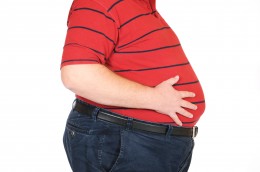Osteoporosis Risk Factors in Men: A Pot Belly Can Indicate Weakened Bones
 Are you a man who’s been getting shorter but wider as you age? That could be a serious risk factor for bone loss.
Are you a man who’s been getting shorter but wider as you age? That could be a serious risk factor for bone loss.
A study has found that belly fat and total abdominal fat in men are proven osteoporosis risk factors, which should cause the alarm bell to sound for men and the women who love them.
Belly fat puts men at risk for bone loss, heart disease, diabetes
Having a pot belly means you are more likely to have weak bones prone to fractures. The first sign of osteoporosis in men is often decreased height due to fractured vertebrae. If you are a man with deep layers of fat around your abdomen, a condition known as visceral obesity, new research shows you’re at risk for more than just heart disease and diabetes.
For the first time, researchers have found that visceral obesity is now one of the important risk factors for osteoporosis in men. If you currently have an unwanted pot belly, this is one more reason to do something about it. Losing weight and increasing muscle mass through moderate exercise should be the long-term goal so that you can remain active and healthy for the next 20 to 30 years.
Visceral versus subcutaneous fat
Not all men who are obese have visceral fat, which lies deep under the muscle tissue in the abdominal cavity. Subcutaneous fat, as opposed to visceral fat, lies just below the skin and is not as dangerous. Excess visceral fat may accumulate because of genetics, poor diet, or lack of exercise. It can be measured using CT scans.
Osteporosis in men doesn’t get the attention it deserves
Osteoporosis in men is finally getting some attention, although it still is fairly unrecognized and undertreated. In the past, men, especially obese men, were not considered to have many osteoporosis risk factors. Newer research, however, has reversed that assumption.
Fractures of the hip and spine are common among elderly men. One third of all hip fractures worldwide occur in men, and men are more likely to die the year following a hip fracture than are women. Spinal fractures are also common and although they are often painless, they result in height loss and have been found to reduce quality of life.
Research findings point to belly fat dangers
A team of researchers led by Dr. Miriam Bredella, MD, a radiologist at Massachusetts General Hospital and associate professor of radiology at Harvard Medical School in Boston, evaluated 35 obese men. The participants’ mean age was 34 and mean body mass index (BMI) was 36.5, indicating obesity.
The research team measured fat and muscle mass using CT of the abdomen and thigh. They also used a special high-resolution CT technique to assess bone strength and predict fracture risk. The new CT scan technique can be used to determine the strength or force necessary to make a bone break.
Results of the study showed that men with higher visceral and total abdominal fat had lower measures of bone strength and increased osteoporosis risk factors compared to those with less visceral and abdominal fat. However, total BMI, which takes into account not just visceral fat but overall weight, including subcutaneous fat, was not found to be associated with bone strength. In other words, obese men with a lot of visceral fat had significantly decreased bone strength compared to obese men with low visceral fat but similar BMI.
Subcutaneous fat was not associated with bone strength. The results also showed that the more muscle mass a man had, the greater his bone strength.
Take action now to protect your bones
If you are a man and have noticed you are not standing as tall as you once did, especially if you have a pot belly, you likely have increased osteoporosis risk factors. For men or women, osteoporosis is a treatable condition responsible for a great deal of pain, disability, and death in the elderly. You can easily measure your own waist circumference to screen for abdominal/visceral obesity. Any man with a waist circumference over 40 inches is likely to have visceral obesity and be at increased risk for osteoporosis.
To find out for sure, it’s important to bring up the topic of bone loss with your healthcare provider, who can order the appropriate screening tests, such as a DEXA scan, and recommend treatment if you do have the disease. Keep in mind that bone is a living tissue and you can increase your bone strength even if you’re found to have weak bones.
As the study found, one way to increase bone strength is to build muscle mass. This is accomplished by regularly lifting weights or performing some other sort of resistance exercise.
[1] Ebeling PR. Clinical practice. Osteoporosis in men. N Engl J Med. 2008 Apr 3;358(14):1474-82. doi: 10.1056/NEJMcp0707217. Review. PubMed PMID: 18385499.
Originally published in 2012, this blog has been updated.


 Bone Spurs on the Spine
Bone Spurs on the Spine  Knee Injections for Osteoarthritis Pain Relief
Knee Injections for Osteoarthritis Pain Relief  What Is a Slipped Rib?
What Is a Slipped Rib? 